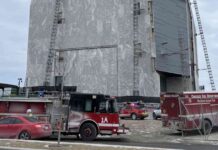January 11, 2002. 9:40 p.m. Bernard C., 53, is driving on the A13 motorway in his Audi 80 alongside his partner, Josyane B., 57. Suddenly, a shock occurs. Bernard does not yet realize the tragedy that has just occurred. His windshield had just been stabbed with a rock, crushing his wife in the chest and severing her aorta and carotid artery. She died instantly, killed by, more specifically, a 10 cm by 15 flint weighing 1.8 kg.
Tragic coincidence for this couple? According to information from Le Parisien, the investigators have relied on another hypothesis. Indeed, the stone was not part of the bridge from which it fell, the Blaru.
Consequently, the prosecutor’s office of Versailles (Yvelines) decided to open an investigation for intentional homicide. Especially since a first victim had already been disfigured by a piece of cinder block in the same place in September 2001. And a few days before the tragedy, on December 31, 2001, stones were thrown from this bridge.
The police officers in charge of the investigations quickly discover the existence of a dented road in the vicinity of the bridge. It is located in the place called Le Buisson. It leads to an abandoned house, near the bridge, frequented by young people from the area.
Soda cans, a McDonald’s burger wrapper, cigarette butts, leftover joints and a receipt were also found on the bridge.
Incidents that took place in the region on the night of the tragedy are consulted. Result: cars were broken all over the town of Bonnières-sur-Seine, near the building.
Le Parisien indicates that on January 17, 2011, the prosecution decided to open a judicial investigation against X for intentional homicide. About 100 interviews are carried out and eight people are taken into custody. But nothing helps: no leads lead to a solid suspect.
Not even the trail of McDonald’s in Mantes-la-Jolie and that of Vernon, where we tried to trace the purchasers of the packaging found on the bridge.
Nor that of the cameras, hidden on the work. The telephony did identify a few people who had already been convicted for similar acts and whose phones were confined to the scene, but no other element revealed a real link with the fatal accident of January 11.
According to Josyane’s family, which speaks in the columns of the media, the reason for the absence of witnesses and suspects is linked to an “omerta”, a law of silence, which prohibits young people present at the time of the events from ‘talk about.
Since 2004, the investigating judge has declared a dismissal in this case.
But if new elements come to light, the investigation could be reopened. It is today the last hope of the relatives of the victim.
They created, after the death of Josyane B., the Road Defense Association against stone throwing. His goal ? Advocate for the installation of anti-throw devices. She will lead the fight until 2012.
In Blaru, the bridge has not changed since 2002.




